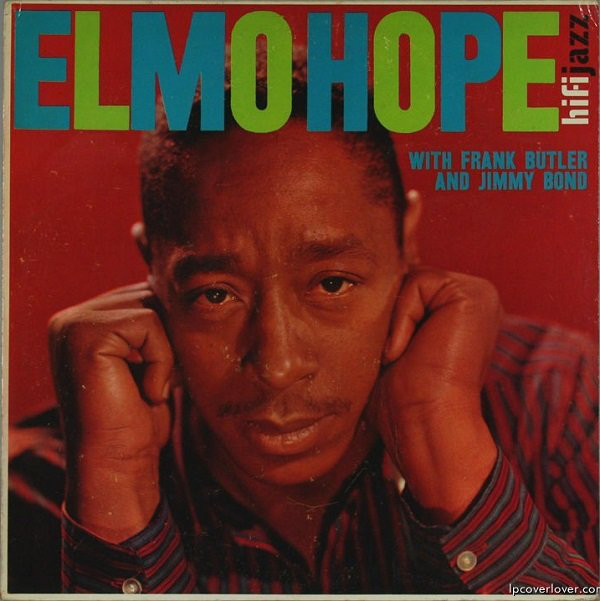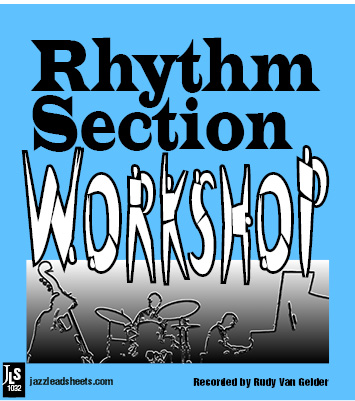Minor Bertha – Elmo Hope
A percussive medium up swinger full of rhythm section hits and a challenging melody with interesting twists and turns. The Bass part is also available from Elmo's recording. It's ideal for our Rhythm Section Workshop series, which, with the aid of individual Minus You tracks, lets each rhythm section player master their part while they lock in with two experienced professional players.
- Recording: Elmo Hope - Elmo Hope
- Recorded on: February 8, 1959
- Label: HiFi Jazz (J616)
- Concert Key: C minor
- Vocal Range: , to
- Style: Swing (medium up)
- Piano - Elmo Hope
- Bass - Jimmy Bond
- Drums - Frank Butler
Purchase Minor Bertha - Elmo Hope
Purchasing this song through our affiliate links with certain retailers provides jazzleadsheets.com with additional support to help keep us bringing you the best lead sheets available. Thank you!
Video
- Pianist/composer Dawn Clement plays Minor Bertha by Elmo Hope on the Wurlitzer.
- Description
- Historical Notes
- Solos
- Piano Corner
- Bass Corner
- Drum Corner
- Guitar Corner
- Inside & Beyond
- Minus You
The drum intro is notated in the C treble clef lead sheet. The drummer's role during the melody is either to play along with or accompany the melody.
The bass part for the A sections is full of stop-and-go action. Although it's all notated on the C treble clef lead sheet, we're also making available a separate two-page bass part (for the melody and solo sections) for reading ease. The Rhythm Section Workshop parts (next album cover) are more complex and are tailored to the Minus You audio tracks.
Along with Minor Bertha, this trio album contains other important original Elmo Hope gems that we'll be making available at jazzleadsheets.com.
For more details about Elmo Hope's recordings, check out the Elmo Hope Discography on Noal Cohen's Jazz History website.
More titles on "Elmo Hope Trio."
Related Songs
Email Send Minor Bertha to a friend
- Recording: SFM Trio - Rhythm Section Workshop
- Recorded on: July 9, 2014
- Label: jazzleadsheets.com (JLS 1032)
- Concert Key: C minor
- Vocal Range: , to
- Style: Swing (medium up)
- Piano - Glenn Zaleski
- Bass - Bill Moring
- Drums - Evan Hughes
Video
- Description
- Historical Notes
- Solos
- Piano Corner
- Bass Corner
- Drum Corner
- Guitar Corner
- Inside & Beyond
- Minus You
About the composition: Nine-measure A sections can be challenging; followed by the 8-measure B section, there's no relief from irregular twists and turns. The piano melody is also full of little embellishments that add to the melodic interest, but also make it more difficult to play. Once you get into the solo section you still have to keep all of your wits together as you continue the 9-9-8-9 measure form.
About the arrangement: I like arrangements that don't require a count off when performing. With the drummer starting with a 4-measure solo variation of the opening melody as the intro, everyone else is ready for their first entrance. Our editions start with Elmo's drummer Frank Butler's original recorded intro notated notated, so you see exactly where to come in as you hear our drummer, Evan Hughes, interpreting the intro on our Minus You tracks. Click on the Minus You tab for details.
On Elmo's original trio recording, after his two solo choruses, he sets up the single bass solo chorus with a nice syncopated figure, and then continues to add very interesting sporadic melodic fills during the bass solo. He continues this during the one-chorus drum solo. For our Rhythm Section Workshop arrangement, after a two-chorus bass solo, I simply orchestrated Elmo's fills for both piano and bass, giving a shout chorus effect to the drum choruses (with the drummer going back and forth from soloing to interacting with figures). Once familiar with Elmo's recording, some pianists may also want to add his first chorus figures behind one of the bass choruses.
About the part editions: This trio arrangement requires separate parts for everyone. The Piano and Drum parts show the melody, with various hit indications to show you what else is going on. The piano figures during the 2-chorus drum solo section are also in the Drum part, so the drummer can easily decide what he wants to play with piano and bass, etc. The Bass part is a written-out part throughout the melody and the two drum choruses, with melody hits under the staff so you know what else is going on.
Note that these parts for Piano (4 pages), Bass (3 pages) & Drums (3 pages) are tailored to the Minus You audio tracks and will certainly help you navigate your way through them. The lead sheets under the Elmo Hope trio album cover are less complex.
Solos: Slashes with "changes" appear on everyone's part to help everyone keep track of where they are on this tricky 9-measure A section form. After two Piano choruses and two Bass choruses, there are two Drum choruses as described above.
Our Rhythm Section Workshop editions have two major goals:
• To create interesting rhythm section arrangements that challenge all the members of the rhythm section.
• To provide Minus You editions, so individual rhythm section players have something to work with on their own, where they can experience playing with other good rhythm section players.
Don Sickler: This is an important and demanding Elmo Hope composition. Elmo recorded it only once. It appears on his classic trio album: "Elmo Hope Trio" (click the record jacket above left for more information). Pianist Paul Moer also recorded it on his 1991 tribute album: "Plays The Music Of Elmo Hope." Later that same year, I suggested it to alto saxophonist James Spaulding who recorded it on his Muse Records album "Songs Of Courage," which I produced. With all of its pianistic melody embellishments, it's challenging but a great experience, fun to play, on a horn. Playing trumpet, I've had had the honor of performing it with pianist Bertha Hope and others over the years, and can personally attest that it is always challenging to play.
Working on this Rhythm Section Workshop edition, I decided to get out the B♭ part from Elmo's edition and play with the Minus Piano track. That's another interesting way horn players can also explore our rhythm section workshop tracks. Just you, bass and drums (with no piano harmonies to help you out.) I always think of the great Sonny Rollins recordings with that combination.
Solos: Slashes with "changes" appear on everyone's part to help everyone keep track of where they are on this tricky 9-measure A section form. After two Piano choruses and two Bass choruses, there are two Drum choruses.
Note from Don Sickler: I was always intrigued by Elmo's comping figures behind the one bass chorus and one drum chorus of his original trio recording, so I decided to incorporate them both into what I guess can best be described as a two-chorus drum solo shout. You keep soloing, but you also have to contend with Elmo's attacking figures, which are now orchestrated for piano and bass. If you haven't heard drummer Frank Butler on Elmo's original recording, you should definitely check him out. Click on the album cover above, left. There's a link to the audio on iTunes.
There are lots of different ways a drummer can approach this Minus Drums track. Our drummer, Evan Hughes, elected to play a lot of the A sections of the melody with variations of "time" on the hi-hat. This was basically my suggestion, to make sure everything would hold together when we eliminated the tracks one instrument at a time for our Minus You audio. Using our track without drums, a drummer could easily try a freer approach, or try playing more melody notes with the piano, as drummer Frank Butler did in Elmo's recording.
You could also take a totally different approach and play brushes throughout, or at least during the melody. Frank Butler switched to brushes for the Bass solo, and he started his solo chorus with brushes, switching to sticks during the piano figures that start the second A section of his drum chorus. Evan Hughes also switched to brushes for the Bass solo, and he stayed on brushes throughout both choruses of his solo, switching to sticks again just in time for the our melody. Quite often drummers like to switch to brushes for bass solos. I'm not always a big fan of this, and I've often asked drummers to stay on sticks for bass solos on my recordings as a leader. So, another approach I'd suggest is to play sticks throughout. Once you check out Elmo's cute melodic interjections during your solo choruses, you might want to take a further lesson from Frank Butler and switch back and forth between sticks and brushes during other melodic attacks by piano and bass.
Try different creative approaches and see what you can make work for you.
[ex] Full trio track. The recording format is:
-- Drum intro
-- melody
-- Piano solo (2 choruses)
-- Bass solo (2 choruses)
[ex} -- Drum choruses (2 choruses with Piano and Bass interplay)
-- out melody
mp3 mp3 minus piano (same two excerpts minus piano)
mp3 mp3 minus bass (same two excerpts minus bass)
mp3 mp3 minus drums (same two excerpts minus drums, also showing snaps for drum solo)
Because the drum intro is notated (the same as Frank Butler's intro on the original recording), we have kept it in our Minus Drum track. A drummer can play along with the notated intro and then continue with the rest of the track which otherwise has only piano and bass. The solo sections of the drum choruses on this track have snaps added on beats 2 and 4, to lock in the time between the piano/bass figures.
Related Songs
Email Send Minor Bertha to a friend

Elmo Hope
June 27, 1923 – May 19, 1967
An imaginative pianist who valued subtlety over virtuosity in the landscape of bebop, Elmo Hope never achieved the fame that his close friends did, perhaps because he so rejected stylistic norms of the time. Elmo was a classically trained pianist with technique rivaling that of his childhood friend Bud Powell and a composer of music whose inventiveness and complexity approaches that of Thelonious Monk. In fact, Elmo, Thelonious and Bud used to hang out so much together in the late 1940s they became known as "The Three Musketeers." Powell, in Francis Paudras' book "Dance of the Infidels" is quoted as saying, "You gotta hear Elmo. He's fabulous. His stuff is very hard. He does some things that even I have trouble playing." Read more...




